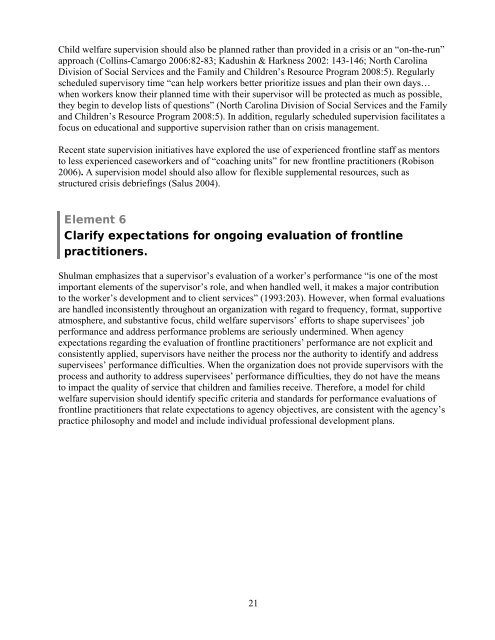Building a Model and Framework for Child Welfare Supervision
Building a Model and Framework for Child Welfare Supervision
Building a Model and Framework for Child Welfare Supervision
- No tags were found...
Create successful ePaper yourself
Turn your PDF publications into a flip-book with our unique Google optimized e-Paper software.
<strong>Child</strong> welfare supervision should also be planned rather than provided in a crisis or an “on-the-run”approach (Collins-Camargo 2006:82-83; Kadushin & Harkness 2002: 143-146; North CarolinaDivision of Social Services <strong>and</strong> the Family <strong>and</strong> <strong>Child</strong>ren’s Resource Program 2008:5). Regularlyscheduled supervisory time “can help workers better prioritize issues <strong>and</strong> plan their own days…when workers know their planned time with their supervisor will be protected as much as possible,they begin to develop lists of questions” (North Carolina Division of Social Services <strong>and</strong> the Family<strong>and</strong> <strong>Child</strong>ren’s Resource Program 2008:5). In addition, regularly scheduled supervision facilitates afocus on educational <strong>and</strong> supportive supervision rather than on crisis management.Recent state supervision initiatives have explored the use of experienced frontline staff as mentorsto less experienced caseworkers <strong>and</strong> of “coaching units” <strong>for</strong> new frontline practitioners (Robison2006). A supervision model should also allow <strong>for</strong> flexible supplemental resources, such asstructured crisis debriefings (Salus 2004).Element 6Clarify expectations <strong>for</strong> ongoing evaluation of frontlinepractitioners.Shulman emphasizes that a supervisor’s evaluation of a worker’s per<strong>for</strong>mance “is one of the mostimportant elements of the supervisor’s role, <strong>and</strong> when h<strong>and</strong>led well, it makes a major contributionto the worker’s development <strong>and</strong> to client services” (1993:203). However, when <strong>for</strong>mal evaluationsare h<strong>and</strong>led inconsistently throughout an organization with regard to frequency, <strong>for</strong>mat, supportiveatmosphere, <strong>and</strong> substantive focus, child welfare supervisors’ ef<strong>for</strong>ts to shape supervisees’ jobper<strong>for</strong>mance <strong>and</strong> address per<strong>for</strong>mance problems are seriously undermined. When agencyexpectations regarding the evaluation of frontline practitioners’ per<strong>for</strong>mance are not explicit <strong>and</strong>consistently applied, supervisors have neither the process nor the authority to identify <strong>and</strong> addresssupervisees’ per<strong>for</strong>mance difficulties. When the organization does not provide supervisors with theprocess <strong>and</strong> authority to address supervisees’ per<strong>for</strong>mance difficulties, they do not have the meansto impact the quality of service that children <strong>and</strong> families receive. There<strong>for</strong>e, a model <strong>for</strong> childwelfare supervision should identify specific criteria <strong>and</strong> st<strong>and</strong>ards <strong>for</strong> per<strong>for</strong>mance evaluations offrontline practitioners that relate expectations to agency objectives, are consistent with the agency’spractice philosophy <strong>and</strong> model <strong>and</strong> include individual professional development plans.21
















